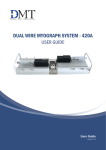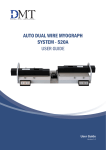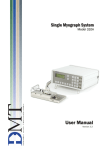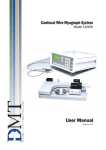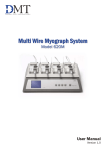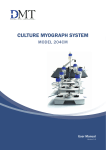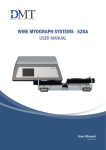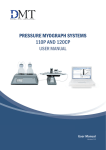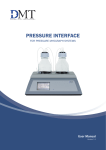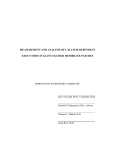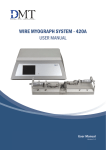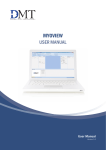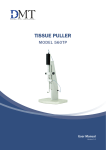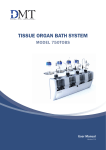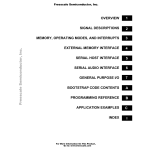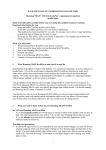Download User Guide for 360CW
Transcript
CONFOCAL WIRE MYOGRAPH SYSTEM - 360CW USER GUIDE User Guide Version 1.0 1 CONTENTS Chapter 1 - Confocal Wire Myograph overview................................................................................................................................ 3 Chapter 2 - Setting up the Confocal Wire Myograph....................................................................................................................... 4 2.1 Adjustment of supports...................................................................................................................................................................... 4 2.2 Special designed jaws........................................................................................................................................................................ 5 2.3 Chamber............................................................................................................................................................................................. 5 2.4 Force transducer calibration.............................................................................................................................................................. 5 Chapter 3 - Experimental set-up ....................................................................................................................................................... 6 3.1 Mounting protocol for small arteries................................................................................................................................................. 6 3.2 Normalization...................................................................................................................................................................................10 3.2.1 Principles of the normalization procedure...............................................................................................................................10 3.3 Standard start..................................................................................................................................................................................10 3.3.1 Principles of the standard start procedure..............................................................................................................................11 3.4 Endothelium function.......................................................................................................................................................................11 3.4.1 Principles of checking endothelium function...........................................................................................................................11 3.5 In vitro experiment 1: Noradrenaline contractile response...........................................................................................................12 3.5.1 Background................................................................................................................................................................................12 3.5.2 Protocol.......................................................................................................................................................................................12 3.6 In vitro experiment 2: Acetylcholine relaxation curve....................................................................................................................13 3.6.1 Background................................................................................................................................................................................13 3.6.2 Protocol.......................................................................................................................................................................................13 Chapter 4 - Cleaning and Maintenance..........................................................................................................................................14 4.1 Cleaning the Confocal Wire Myograph............................................................................................................................................14 4.2 Maintenance of the force transducer.............................................................................................................................................15 4.2.1 Checking the force transducer..................................................................................................................................................15 4.2.2 Force transducer replacement..................................................................................................................................................16 4.3 Changing Confocal Wire Myograph window glass..........................................................................................................................16 4.4 Maintenance of the linear slides.....................................................................................................................................................16 Appendix 1 - Buffer recipes............................................................................................................................................................. 17 Appendix 2 - Normalization theory..................................................................................................................................................19 Appendix 3 - Reading a millimetre micrometer.............................................................................................................................21 2 CONFOCAL WIRE MYOGRAPH SYSTEM - 360CW - USER GUIDE CHAPTER 1 - CONFOCAL WIRE MYOGRAPH OVERVIEW Port for connection with Wire Interface Vertical micrometer screw Horizontal micrometer Allen screws for fine alignment of the wire jaws (2 on each side) Wire jaw connected to force transducer Wire jaw connected to horizontal micrometer Force transducer pin Window at the bottom of the Myograph chamber for imaging (under the wire jaws) Figure 1.1 Confocal Wire Myograph with close-up of the chamber Inlet for adding drugs Suction connection Oxygen supply Spare connection (for chamber superfusion) Figure 1.2 Chamber cover CHAPTER 1 3 CHAPTER 2 - SETTING UP THE CONFOCAL WIRE MYOGRAPH 2.1 Adjustment of supports A successful mounting of any kind of tubular tissue segment in the Confocal Wire Myograph is very dependent on perfectly matching supports. The supports are matched prior to the shipment but daily use of the Confocal Wire Myograph and greasing of the transducer pinhole will over time create a need for an adjustment of the supports. NOTE THE TRANSDUCERS ARE FRAGILE AND SENSITIVE TO MECHANICAL STRAIN. BE VERY CAUTIOUS NOT TO PUT STRAIN ON THE TRANSDUCER WHEN CHANGING OR ADJUSTING THE MOUNTING SUPPORTS. IN ADDITION, VERY LITTLE FORCE SHOULD BE APPLIED TO THE SCREWS IN ORDER TO AVOID BREAKING THE THREADS. Adjustment of the supports is performed using the following step-by-step procedure. The procedure is illustrated in figure 2.1 below. 1. C arefully loosen screw “A” on the top of the support connected to the force transducer. Align the horizontal support and carefully tighten the screw again. 2. L oosen screw “B” on the top of the support connected to the linear slide. Align the horizontal support matching the force transducer connected support as carefully as possible and gently tighten the screw again. 3. L oosen screw “C” on the linear slide to roughly match the linear slide support to the force transducer support in the horizontal plane. Tighten the screw before proceeding with step 4. 4. T he plate on which the linear slide is mounted is balanced on top of a small stainless steel ball making it possible to finely adjust the linear slide support in all vertical and horizontal planes using the four Allen screws “D”. Use the four Allen screws to make the final horizontal and vertical adjustments to match the linear slide support to the force transducer support. The correct matching of the supports is illustrated in figure 2.2. IMPORTANT BE CAREFUL TIGHTEN THE ALLEN SCREWS WHEN DOING THE FINAL ADJUSTMENTS. ALWAYS REMEMBER TO LOOSEN THE ALLEN SCREW PLACED DIAGONAL TO THE ALLEN SCREW BEING TIGHTENED OTHERWISE THERE IS A HIGH RISK OF DAMAGING THE CONFOCAL WIRE MYOGRAPH FRAME. A. Screw on support connected to the force transducer C. Screw on the linear slide D. Four Allen screws B. Screw on support connected to the linear slide Figure 2.1 Illustration of how to adjust the supports 4 CONFOCAL WIRE MYOGRAPH SYSTEM - 360CW - USER GUIDE Figure 2.2 Illustration of correctly aligned supports of the Confocal Wire Myograph special designed jaws - view from the side (left) and view from the top (right) 2.2 Special designed jaws The Confocal Wire Myograph is supplied with jaws for inverted scopes but can be used with normal stainless steel jaws to mount small vessels on an upright system. For experimental work requiring electrical field stimulation a set of plastic jaws with attached platinum electrodes is available. 2.3 Chamber The chamber has a conical shape and can thus be used with a small amount of buffer liquid. The chamber can be customized to operate with volumes of 3 ml. or less. The conical milling on the bottom outside of the chamber allows objectives on inverted microscopes to be raised to the thin glass window to accommodate very low working distance objectives. 2.4 Force calibration DMT recommends that the Confocal Wire Myograph is force calibrated at least once every month. DMT also recommends that the Myograph is force calibrated every time the system has been moved or has not been used for a long period of time. See the force calibration procedure in chapter 3.7.1 in Wire Myograph Systems - User Manual. CHAPTER 2 5 CHAPTER 3 - EXPERIMENTAL SET-UP This chapter contains experimental set-up for the Confocal Wire Myograph. For dissection of a vessel, please see Procedures for investigations of small vessels using a small vessel Myograph by M.J. Mulvany. 3.1 Mounting protocol for small arteries The difficulty of mounting ring preparations in any Wire Myograph mostly depends on the lumen size. The Wire Myograph technique is usable for ring preparations with internal diameter >100 μm using 40 μm stainless steel wires. 25 μm tungsten wires are available for ring preparations with an internal diameter as low as 60 μm. For large diameter vessels, mounting pins (200 µm and larger) are an available option. The Confocal Wire Myograph reverse mounting jaws are shaped with pegs at the bottom, to position the vessel as close as possible to the objective of the inverted confocal microscope. The special jaws (with a vessel mounted) are illustrated in figure 3.1. The pegs make the mounting of the vessel a little more difficult than in the other Wire Myographs. Another difference from the other Wire Myographs is that the mounting supports for the jaws are longer and thus less rigid. Slight pressure on the jaw can result in a significant stress upon the mounting supports. On the transducer side this results in stress upon the transducer pin, which could damage the transducer. Furthermore, there is a risk you will push the jaws out of alignment. For these reasons the demands upon your carefulness and awareness are increased in these procedures. These instructions hopefully will help you to succeed with the mounting procedure. Experience with mounting in other Wire Myographs is an advantage and will ease the process. Figure 3.1 Illustartion of mounted vessel in Confocal Wire Myograph special designed jaws 1. A vessel (size 150–500 μm) is dissected as described in Procedures for investigations of small vessels using a small vessel Myograph by M.J. Mulvany. 3. Before mounting, it is important that the cover slip (diameter 19 mm, the thickness may need to be optimized to your optics) at the bottom of the Confoacl Wire Myograph is clean. It is recommended that the glass be changed every day. To ease this process, the top part of the Confoacl Wire Myograph with the heads can be tilted up and out of the way: this also permits easy access for cleaning. To remove the old glass, press up gently from below. Remove the old grease and fix the new glass with a little grease (high vacuum grease). It is important to remove any air bubbles between the glass and the chamber to ensure a good, water-tight seal. 4. It is also important that the mounting heads are carefully adjusted and aligned, so that there are no disturbances in the force recording, when the heads are close together. The alignment procedure is described in chaper 2.1. For the mounting procedure the following equipment is used: a stereomicroscope (magnification 4-40×) and a fibre light source, two pairs of fine forceps, a pair of fine scissors (trabecular type), a small screwdriver and wire. 5. To have as much space as possible, move the supports up with the vertical micrometer screw before you start the mounting procedure. 6. Place the Confoacl Wire Myograph in front of you, with the micrometer to your right. 6 CONFOCAL WIRE MYOGRAPH SYSTEM - 360CW - USER GUIDE 7. Close heads partly. 8. Hold a wire with the forceps one-third from the top. Place the wire between the heads underneath the top left peg and over the lower right peg. 9. When the wire is in position, the heads are moved together and the top end of the wire is bent up and fixed by the top left screw. Remember always to place the wires clockwise under the screw heads, so that tightening of the screws will tighten the wires too. 10.The protruding wire should be straight, and long enough to reach the lower left screw. Excess wire can be cut off. ++ cold ColdPSS PPS 11.Fill the chamber with cold PSS and transfer the vessel to the Confoacl Wire Myograph chamber. See appendix 1 for example of buffer recipes. 12.Holding the vessel close to the proximal end with the forceps, the vessel is mounted onto the wire. 13.The vessel can now be cut off to give it the right length to fit the gap between the shortest pegs (2 mm). Add a little bit more = the width of one peg. (Explanation follows in step 15). CHAPTER 3 7 14. The jaws are now moved widely apart and the wire is released, so the vessel can pass the pegs without touching them and thereby be damaged. 15. The vessel is pulled gently up the wire and the wire is positioned underneath the top left peg. NOTE WHEN THE PROXIMAL END OF THE VESSEL IS FIXED BETWEEN THE WIRE AND THE PEG THIS PREVENTS THE VESSEL SLIPPING DOWN AND BECOMING COMPRESSED WHEN THE SECOND WIRE IS INSERTED. THE VESSEL SHOULD NOT BE FIXED AT THE DISTAL END. A FIXATION AT THE DISTAL END WOULD HINDER THE VESSEL TO MOVE FREELY IN THE LONGITUDINAL DIRECTION. 16. The wire is fixed with the lower left screw and at the same time is pulled to run tight from the screws along the head and underneath the left pegs. The vessel should run parallel to the front of the head. 17. A long wire (25 mm) is bent one-third from the top in a 90º angle. This wire is guided into the vessel along the first wire from the top end of the vessel. When the wire is through the whole length of the vessel, it is cautiously pulled through the rest of the way, until it passes the lower right peg and enough wire is through to reach the lower right screw. 18. The jaws are screwed closely together. The top end of the wire, with the 90º angle, should point upwards between the jaws and the wire should run underneath the right side pegs. 19. To ease the coming steps, which maybe the most critical ones for a viable preparation, the myograph is turned 90 degrees, so the vessel runs from right to left. 8 CONFOCAL WIRE MYOGRAPH SYSTEM - 360CW - USER GUIDE 20. The top end of the second wire is bent towards the top right screw (the screws are still named as if the Confoacl Wire Myograph was not turned 90o.) and fixed below the screw head. Take care that the vessel is not stretched or moved in the longitudinal direction. You might prevent this by holding the other end of the wire with your second pair of forceps. 21. The lower end of the wire now needs to be fixed to the lower right screw. Take care that the second wire is mounted parallel to the first wire and (of course) on the outside of it. Remember again that the wire should be straight and tight. 22. By looking in the microscope and at the same time watching the force signal, the height of the left wire is adjusted to allow it to move freely when the wires are moved together or away from each other. The height of the wire is adjusted by adjusting the Allen keys on the micrometer side. Move the Confoacl Wire Myograph to the confocal microscope and attach bubbling to the bath. Connect the Confocal Wire Myograph to the Wire Interface and turn the heating on. Zeroing of the micrometer (X0) can now be done (wires moved together until they are just touching) and a normalization performed (as described in the next section). After the artery is normalized, contractility tested and loading with the fluorescent dye completed, move the heads downwards with the vertical micrometer to position the artery just above the cover slip. Once you can see the jaws are close to the cover slip, follow the force reading on the Myo-Interface. It is important to now advance slowly and carefully - too much downwards force and you will put unnecessary strain on the transducer and risk cracking the cover slip. When the artery is touching the bottom of the chamber the force reading with increase. At this point, move the artery up slightly. The artery is now positioned for imaging and the objective should be able to focus on the vessel. Note that movement artifacts can occur when the artery is stimulated with agonists or depolarized with potassium. This factor can be somewhat avoided by the use of ratiometric dyes. Contraction can be inhibited by wortmannin, which covalently binds to the myosin light-chain kinase. Alternatively, the artery can be hyperpolarized with potassium channel openers thereby preventing the opening of voltage-sensitive calcium channels and contraction. CHAPTER 3 9 3.2 Normalization The importance of normalizing the preparation is three-fold: 1. Experiments with elastic preparations like vessels can only have meaning if they are performed under conditions where the size is clearly defined. 2. Clearly defined conditions are required in pharmacological experiments as the sensitivity of preparations to agonists and antagonists is dependent on the amount of stretch. 3. The active response of a preparation is dependent on the extent of stretch, which makes it important to set the preparation to an internal circumference giving maximal response. The aim of the normalization procedure is to stretch the segment to a so-called normalized internal circumference (IC100): defined as a set fraction of the internal circumference (IC100) that a fully relaxed segment would have, at a specified transmural pressure. For small rat arteries the target transmural pressure is typically 100 mmHg = 13.3 kPa. 3.2.1 Principles of the normalization procedure In practice the normalization is performed by distending the segment stepwise and measuring sets of micrometer and force readings (figure 3.2). These data are converted into values of internal circumference (μm) and wall tension T (mN/mm) respectively. Plotting wall tension against internal circumference reveals an exponential curve and by applying the isobar curve corresponding to 100 mmHg, IC100 is calculated from the point of intersection using the Laplace relation (figure 3.3). IC1 is calculated from IC100 by multiplying a factor giving an internal circumference at which the active force production as well as the sensitivity to agonists of the segment is maximal. For rat mesenteric arteries the factor is 0.9 but both this factor as well as the transmural pressure has to be optimized for each particular segment. The normalized internal diameter is calculated by dividing IC1 with . Appendix 2 contains a complete description of the mathematical rationale and calculations of the normalization procedure. Figure 3.2 Illustration of the stepwise normalization procedure Figure 3.3 Illustration of the exponential curve fitting and determination of IC100 3.3 Standard start The purpose of performing a standard start is to: 1. Re-activate the mechanical and functional properties of the vessel segment. 2. C heck that responses to different types of stimuli are normal in appearance and thereby ensuring that the functionality of the vessel segment has not been damaged during the dissection or mounting procedures. 3. E nsure that the tension development gives an effective active pressure that is above the chosen accepted value (usually 13.3 kPa = 100 mmHg). The standard start is performed after the vessel segment has been heated, equilibrated and normalized. The present procedure is suitable for rat mesenteric arteries. Another procedure may be needed for other animal species and tissue or vessel types. 10 CONFOCAL WIRE MYOGRAPH SYSTEM - 360CW - USER GUIDE 3.3.1 Principles of the standard start procedure The standard start procedure consists of a series of five stimuli and washout periods. The first two stimuli are performed using a mixture of KPSS and 10 μM noradrenaline to give a maximum contractile response. The third stimulus is performed using a mixture of PSS and 10 μM noradrenaline to give a maximum pure agonist mediated (α-adrenoceptor) contraction. The fourth stimulus is performed using KPSS to give a depolarising contractile response (this stimulus also includes a component from neurally released noradrenaline). The final stimulus is performed using a mixture of PSS and 10 μM noradrenaline. All solutions are preheated to 37oC and aerated with a mixture of 95% O2 and 5% CO2 before use. Instructions for making the necessary solutions are described in appendix 1. Repeat 1 x -- Stimulus 1 & 2 -KPSS + 10 μM NA Stimulate for 3 minutes -- Wash out -4 x with PSS Wait 5 minutes -- Stimulus 3 -PSS + 10 μM NA Stimulate for 3 minutes -- Wash out -4 x with PSS Wait 5 minutes -- Stimulus 4 -KPSS Stimulate for 3 minutes -- Wash out -4 x with PSS Wait 5 minutes -- Stimulus 5 -KPSS + 10 μM NA Stimulate for 3 minutes -- Wash out -4 x with PSS Ready for experiment 3.4 Endothelium function The reasons for checking endothelium function may include: 1. To check whether the relaxing function of the endothelium is intact. The procedure is performed to make sure that the endothelium is not damaged during the dissection or mounting procedure. 2. If an experiment requires removal of the endothelium this procedure is useful to check whether the endothelial cells were successfully removed. The procedure can be performed after the vessel segment has been heated, equilibrated and normalized. Preferably the procedure should be done after performing a standard start to make sure that the vessel segment is viable. The present procedure is for use with rat mesenteric arteries. Another procedure may be needed for other animal species and tissue or vessel types. 3.4.1 Principles of checking endothelium function Stimulating a vessel segment with acetylcholine causes a release of nitric oxide (NO, also known as EDRF) from the endothelium cells and subsequent relaxation of the vascular smooth muscle cells. If the endothelium is undamaged by the dissection and mounting procedures, then a substantial relaxation will occur. With complete removal or damaged endothelium, a partial relaxation or no relaxation to acetylcholine is observed. It is important to note that the amount of NO or EDRF in a vessel is often dependent upon its size. In certain vessels, endotheliumderived hyperpolarizing factor (EDHF) can contribute more or less than EDRF, and in other vessels the same stimulation with ACh can promote release of endothelium-derived contracting factor (EDCF). Therefore, it is important to check the existing literature in order to determine the expected response in your particular vessel with the given concentration of agonist. CHAPTER 3 11 3.5 In vitro experiment 1: Noradrenaline contractile response The purpose of the present protocol is to determine the sensitivity of rat mesenteric small arteries to the vasoconstrictor noradrenaline/norepinephrine with a cumulative concentration-response curve. 3.5.1 Background Noradrenaline (norepinephrine) causes contraction of mesenteric small arteries through activation of α-adrenoceptors whereas noradrenaline activation of β-adrenoceptors causes vasodilatation. As the purpose is to determine the contraction sensitivity to noradrenaline, the vasodilatory effect of noradrenaline is eliminated throughout the experiment by the constant presence of the β-adrenoceptor antagonist, propranolol. Rat mesenteric arteries are densely innervated by sympathetic nerves, which have a highly efficient reuptake mechanism that removes noradrenaline from the neuromuscular junction. The reuptake mechanism will create a concentration gradient between the solution around the vessel segment and the receptors on the smooth muscle. To correctly determine the sensitivity to noradrenaline it is necessary to eliminate this concentration gradient by performing the experiment in the presence of cocaine to block the noradrenaline reuptake. To determine the sensitivity to noradrenaline the vessel segment is exposed to increasing concentrations of noradrenaline. Each concentration is applied until a steady response has been reached and then the next concentration is applied. When the vessel segment is fully contracted or does not response more upon increasing the noradrenaline concentration, the experiment is ended. 3.5.2 Protocol Prepare the following stock solutions: Noradrenaline:10-4, 10-3, 10-2 M Propranolol:10-3 M Cocaine: 10-3 M 1. Mount and normalize the vessels as described in chapter 3.1 and 3.2. 2. Perform a standard start as described in chapter 3.3. 3. Incubate the vessel segment in 1 μM propranolol (add 5 µL of 10-3 M to 5 mL PSS in chamber) and 3 μM cocaine (add 15 µL of 10-3 M to 5 mL PSS in chamber) for at least 10 minutes. 4. Add increasing concentrations of noradrenaline into the bath (use the table below as a guideline). Wait for a stable contractile response or a standard time such as 2 minutes between each application. [NA] in chamber (µM)* Volume of stock solution to add to chamber 0.1 5 μL of 10-4 M 0.3 1 μL of 10-3 M 0.5 1 μL of 10-3 M 1 2.5 μL of 10-3 M 1.3 1.5 μL of 10-3 M 1.5 1 μL of 10-3 M 3 7.5 μL of 10-3 M 5 1 μL of 10-2 M 10 2.5 μL of 10-2 M *In calculating the [NA] in the Confocal Wire Myograph chamber, the applied volume of noradrenaline is ignored. 12 CONFOCAL WIRE MYOGRAPH SYSTEM - 360CW - USER GUIDE 3.6 In vitro experiment 2: Acetylcholine relaxation curve The purpose of the present protocol is to determine the sensitivity of the endothelium dependent vasodilator acetylcholine in noradrenaline pre-contracted rat mesenteric small arteries. 3.6.1 Background Acetylcholine causes relaxation of rat mesenteric small arteries by activating of muscarinic M3 receptors at the endothelial cell layer leading to release of endothelium-derived relaxing factors. Rat mesenteric arteries do not show spontaneous tone in the wire myograph, which is why it is necessary to first induce a contraction to be able to observe the relaxation to acetylcholine. In this protocol the contraction is induced by noradrenaline. The required concentration of noradrenaline needs to be optimized since a too low concentration makes it impossible to evaluate the relaxation. On the other hand it may be difficult to relax super maximally contracted arteries, which may lead to an underestimation of the sensitivity to acetylcholine. Therefore it is recommended to apply a concentration of noradrenaline inducing 60-70% of maximal contraction response. In practice this concentration is found by performing a noradrenaline concentration-response curve as described in the previous section. The vessel segment is exposed to the noradrenaline concentration and when the response has stabilised, increasing concentrations of acetylcholine are added to relax the vessel. Each concentration is applied until a steady response has been reached and then the next concentration is applied. When the vessel segment is either fully relaxed or does not relax more upon increasing the acetylcholine concentration, the experiment is ended. 3.6.2 Protocol Prepare the following stock solutions: Acetylcholine:10-4, 10-3, 10-2 M Noradrenaline:10-2 M 1. Mount and normalize the vessels as described in chapter 3.1 and 3.2. 2. Perform a standard start and check the vessel segment for endothelium function, as described in chapter 3.3 and 3.4. 3. A dd noradrenaline to obtain a response around 60% of maximum (determined from the previous noradrenaline concentration-response curve). When the contractile response is stable, add increasing concentrations of acetylcholine to the chamber, using the table below as a guideline. Wait for a stable contractile response or a standard time such as two minutes between each application. [ACh] in chamber (µM)* Volume of stock solution to add to chamber 0.1 5 μL of 10-4 M 0.3 1 μL of 10-3 M 0.5 1 μL of 10-3 M 1 2.5 μL of 10-3 M 1.3 1.5 μL of 10-3 M 1.5 1 μL of 10-3 M 3 7.5 μL of 10-3 M 5 1 μL of 10-2 M 10 2.5 μL of 10-2 M *In calculating the [ACh] in the Confocal Wire Myograph chamber, the applied volume of ACh is ignored. CHAPTER 3 13 CHAPTER 4 - CLEANING AND MAINTENANCE The Confocal Wire Myograph is a very delicate and sophisticated piece of research equipment. In order to keep it working at its best, DMT recommend that the following sections are read carefully and that the instructions are followed at all times. As a part of the general maintenance of the Confocal Wire Myograph, DMT recommends that the Confocal Wire Myograph is force calibrated at least once a month. The Confocal Wire Myograph should also be force calibrated every time the Wire Interface has been moved. Although lab benches are all supposedly perfectly horizontal, small differences in lab bench pitch can affect the calibration of the system. The Confocal Wire Myograph also should be calibrated if the system has been idle for longer than a month. A step-by-step procedure is explained in chapter 3.7.1 in Wire Myograph System - User Manual. 4.1 Cleaning the Confocal Wire Myograph DMT STRONGLY RECOMMENDS THAT THE CONFOCAL WIRE MYOGRAPH AND SURROUNDINGS BE CLEANED AFTER EACH EXPERIMENT. After an experiment use the following procedure to clean the chamber and supports: 1. F ill the chamber to the edge with an 8% acetic acid solution and allow it to stand for a few minutes to dissolve calcium deposits and other salt build-up. Use a swab stick to mechanically clean all the surfaces of the Confocal Wire Myograph. 2. Remove the acetic acid and wash the chamber and jaws several times with double distilled water. 3. If any kind of hydrophobic reagent have been used, which might be difficult to remove using step 1 and 2, then try incubating the chamber and jaws with 96% ethanol or a weak detergent solution. 4. T o remove more resistant or toxic chemicals, incubate the chamber and glass cannulas with 1M HCl for up to 1 hour. In exceptional cases incubate the chamber and supports with a up to 3M HNO3 solution for about 15 minutes. 5. Wash the chamber and supports several times with double distilled water. To prevent the pipes from being blocked by buffer salt deposits after an experiment, use the chamber cover to remove the cleaning solutions. Afterwards, remove the cover from the chamber and turn on the vacuum pump for about 10 seconds. Wait to turn off the oxygen supply until turning off the vacuum pump. Wipe off any buffer remaining on the outside of the pipes using a piece of tissue. IMPORTANT NOTES BE VERY CAREFUL USING STEP 3 AND 4 REPEATEDLY AS STRONG REAGENTS CAN CAUSE EXTREME DAMAGE TO THE WIRE MYOGRAPH. BE VERY CAREFUL NOT TO EXERT ANY FORCE ON THE WIRE JAWS DURING THE CLEANING PROCEDURE. AFTER CLEANING, ALWAYS CHECK THAT THE GREASING AROUND THE TRANSDUCER PIN IS SUFFICIENT TO KEEP OUT THE BUFFER SOLUTION FROM THE TRANSDUCER COMPARTMENT (SEE FIGURE 3.1). In cases of red or brown discolorations appearing on the chamber sides or on the supports, the following cleaning procedure will work in most cases: 1. Incubate the myograph chamber for 30 minutes with 20μl of a 2 mM T-1210 Tetrakis-(2-pyridylmethyl)-ethylenediamine solution dissolved in double distilled water. 2. Use a swab-stick to mechanically clean all the affected surfaces during the last 15 minutes of the incubation period. 3. Wash the chamber several times with double distilled water. 4. Incubate the chamber with 96% ethanol for 10 minutes while continuing the mechanical cleaning with a swab-stick. 5. R emove the ethanol solution and wash a few times with double distilled water. Incubate the chamber with an 8% acetic acid solution for 10 minutes and continue the mechanical cleaning with a swab-stick. 6. Wash the chamber several times with double distilled water. IMPORTANT NOTES IN EXCEPTIONAL CASES IT MAY BE NECESSARY TO REMOVE THE SUPPORTS FOR INDIVIDUAL CLEANING TO MAKE SURE THAT ALL SURFACES ARE CLEAN. 14 CONFOCAL WIRE MYOGRAPH SYSTEM - 360CW - USER GUIDE 4.2 Maintenance of the force transducer The force transducer is the most delicate and fragile component of the myograph system. Therefore careful handling is important. One of the jaws is connected to the transducer pin. To prevent the buffer from running into the transducer house the hole is filled with high vacuum grease (see figure 4.1 below). As part of the daily maintenance, it is very important to inspect the greasing of the transducer hole before starting any experiment. Insufficient greasing causes damage and malfunction of the force transducer. IMPORTANT: DMT RECOMMENDS THAT THE HIGH VACUUM GREASE SEALING THE TRANSDUCER PINHOLE IS CHECKED AND SEALED AT LEAST ONCE A WEEK, ESPECIALLY IF THE MYOGRAPH SYSTEM IS USED FREQUENTLY. DMT TAKES NO RESPONSIBILITIES FOR THE USE OF ANY OTHER KINDS OF HIGH VACUUM GREASE THAN THE ONE TO BE PURCHASED FROM DMT. DMT TAKES NO RESPONSIBILITIES FOR ANY KIND OF DAMAGE APPLIED TO THE FORCE TRANSDUCER. Figure 4.1 Transducer pin hole to be sealed up with high vacuum grease 4.2.1 Checking the force transducer The force transducer is a strain gauge connected in a Wheatstone bridge. The force transducer is placed in a separate compartment on top of the Wire Myograph. The separate compartment provides some mechanical protection for the force transducer but the transducer is still very vulnerable to applied forces exceeding 1 newton (100 gram) or fluid running into the transducer compartment due to insufficient greasing of the transducer pinhole. This section describes how to check the force transducer for any kind of damage. Simple force transducer check 1. If the force reading on the Wire Interface appears unstable, then first check that the Wire Interface and the Confocal Wire Myograph are properly connected through the 25-pin grey cable. 2. If the force reading still appears unstable, then perform a new force calibration of the force transduce. During the force calibration, monitor the relative force reading values in the Calibration Menu on the Wire Interface: • If the value is 0 or above 6500, then the force transducer is broken and needs to be changed. • If the reading is between 1–499 or 3001–6250 then contact DMT for further instructions. CHAPTER 4 15 4.2.2 Force transducer replacement In case that the force transducer is broken and needs to be changed, please contact DMT for further instructions. 4.3 Changing Confocal Wire Myograph window glass The glass in the Confoacl Wire Myograph chamber window is fixed in place and kept waterproof by a thin layer of high vacuum grease on the circular edge between the glass and the chamber base. Daily use of the Confoacl Wire Myograph objectives that require water or other immersion solvents will mean that the glass needs to be replaced daily prior to mounting. The following procedure describes how to change the Confoacl Wire Myograph window glass: 1. Carefully loosen the glass from the chamber edge using small forceps or similar tool. 2. Clean the edge at the bottom of the chamber to remove any remaining old grease. 3. C arefully apply a small amount of high vacuum grease around the edge using a wood stick or similar equipment. Take a new window glass using forceps and gently push it into place. Before starting a new experiment make sure that the complete edge is sealed up with high vacuum grease to keep the Myograph window waterproof. 4.4 Maintenance of the linear slides Check the linear slides (underneath the black cover) for grease at least once a week. In case of insufficient lubrication, grease the slides with the original enclosed grease for linear slides at the places marked by the arrows in figure 4.2 below. NOTE ONLY USE THE GREASE MARKED WITH “GREASE FOR LINEAR SLIDES”. Figure 4.2 Greasing points on the linear slides 16 CONFOCAL WIRE MYOGRAPH SYSTEM - 360CW - USER GUIDE APPENDIX 1 - BUFFER RECIPES Physiological Saline Solution (PSS) 1x PSS: ChemicalMol.WtmMg/0.5Lg/Lg/2Lg/4L NaCl(58.45)1303.7997.59815.2030.39 KCl(74.557)4.70.1750.350.701.40 KH2PO4 (136.09)1.180.080.160.320.64 MgSO4 7H2O (246.498)1.170.1450.290.581.16 NaHCO3 (84.01)14.90.6251.252.505.00 Glucose(180.16)5.50.51.002.004.00 EDTA(380)0.0260.0050.010.020.04 CaCl2(110.99)1.160.8mL1.6mL3.2mL6.4mL (1.0 M solution) 1. Make a 1.0M solution of CaCl2 (110.99) in double-distilled H2O. Filter-sterilize the calcium solution through a 0.22 μm filter. The sterilized solution can be stored in the refrigerator for up to 3 months. 2. Dissolve all the chemicals except the CaCl2 in approximately 80% of the desired final volume of double distilled H2O while being constantly stirred. For example, if 1 litre of PSS is to be made, then dissolve all the chemicals in 800mL of double distilled H2O. 3. Add the appropriate volume of 1.0M CaCl2 for the total volume of PSS being made (for example, 1.6mL of 1.0M CaCl2 for 1 litre of buffer). Continue to stir the PSS while the CaCl2 is being added. 4. Bring the solution up to the final volume with double-distilled H2O. Continue to stir the solution until the EDTA is fully dissolved. This takes about 15 minutes at room temperature. 5. Aerate the solution with carbogen (95% O2 + 5% CO2) for about 20 minutes. 25x Concentrated PSS: ChemicalMol.WtmMg/0.5Lg/Lg/2Lg/4L NaCl(58.45)325094.98189.96379.92759.84 KCl(74.557)117.54.3758.7517.535.0 KH2PO4 (136.09)29.52.04.08.016.0 MgSO4 7H2O (246.498)29.253.6257.2514.529.0 NaHCO3 (84.01)14.90.6251.252.505.00 Glucose(180.16)5.50.51.002.004.00 EDTA(380)0.650.1250.250.501.0 CaCl2(110.99)4020mL40mL80mL160mL (1.0 M solution) APPENDIX 1 17 1. Make a 1.0M solution of CaCl2 (110.99) in double-distilled H2O. Filter-sterilize the calcium solution through a 0.22 μm filter. The sterilized solution can be stored in the refrigerator for up to 3 months. 2. Dissolve all the chemicals except the CaCl2 in approximately 80% of the desired final volume of double distilled H2O while being constantly stirred. For example, if 1 litre of PSS is to be made, then dissolve all the chemicals in 800mL of double distilled H2O. 3. Add the appropriate volume of 1.0M CaCl2 for the total volume of PSS being made (for example, 1.6mL of 1.0M CaCl2 for 1 litre of buffer). Continue to stir the PSS while the CaCl2 is being added. 4. Bring the solution up to the final volume with double-distilled H2O. Continue to stir the solution until the EDTA is fully dissolved. This takes about 15 minutes at room temperature. Before use: 5. Dilute the 25 x PSS stock solution 1:25 using double distilled H2O. 6. Add: 091 g/L Glucose 100 g/L NaHCO3 7. Aerate the solution with carbogen (95%O2 + 5%CO2) for at least 20 minutes. If necessary wait further for the pH of the buffer to reach pH 7.4. High potassium Physiological Saline Solution (KPSS) 1x 60mM KPSS: ChemicalMol.WtmMg/0.5Lg/Lg/2Lg/4L NaCl(58.45)74.72.184.378.7317.46 KCl(74.557)602.244.478.9517.89 KH2PO4 (136.09)1.180.080.160.320.64 MgSO4 7H2O (246.498)1.170.1450.290.581.16 NaHCO3 (84.01)14.90.6251.002.005.00 Glucose(180.16)5.50.51.002.004.00 EDTA(380)0.0260.0050.010.020.04 CaCl2(110.99)1.60.8mL1.6mL3.2mL6.4mL (1.0 M solution) 1. Make a 1.0M solution of CaCl2 (110.99) in double-distilled H2O. Filter-sterilize the calcium solution through a 0.22 μm filter. The sterilized solution can be stored in the refrigerator for up to 3 months. 2. Dissolve all the chemicals except the CaCl2 in approximately 80% of the desired final volume of double distilled H2O while being constantly stirred. For example, if 1 litre of PSS is to be made, then dissolve all the chemicals in 800mL of double distilled H2O. 3. Add the appropriate volume of 1.0M CaCl2 for the total volume of PSS being made (for example, 1.6mL of 1.0M CaCl2 for 1 litre of buffer). Continue to stir the PSS while the CaCl2 is being added. 4. Bring the solution up to the final volume with double-distilled H2O. Continue to stir the solution until the EDTA is fully dissolved. This takes about 15 minutes at room temperature. 5. Aerate the solution with carbogen (95% O2 + 5% CO2) for about 20 minutes. 18 CONFOCAL WIRE MYOGRAPH SYSTEM - 360CW - USER GUIDE APPENDIX 2 - NORMALIZATION THEORY The importance of making a normalization before initiating an experiment with any tubular tissue segment is described in chapter 3.2. In this appendix the mathematical rationale and calculations underlying the normalization procedure are described in detail. Mathematical calculations Let (Xi, Yi) be the pair of values representing the micrometer reading (see appendix 3) and force reading respectively characterizing each step in the normalization procedure. Y0 is the force reading at the start position of the normalization procedure where the wires are just separated and the force reading is approximately zero. Then, given that tension on the vessel is equal to force divided by wall length, the wall tension at the i-th micrometer reading is calculated by: Ti = (Yi – Y0) 2δ • (a1 – a2) where δ is the microscope eyepiece reticule calibration factor in mm per division and a1 and a2 are the vessel end points when measuring the length of the mounted vessel segment. The internal circumference of the mounted vessel at the i-th reading is calculated by: ICi= IC0 + (2•(Xi – X0)) where IC0 is the internal circumference of the mounted vessel when the wires are just separated and is given by: IC0 = (2 + ) • d where d is the wire diameter. For 40 µm wires, IC0 = 205.6 µm. Using the Laplace relation, the effective pressure Pi is calculated for each pair of readings. The effective pressure is an estimate of the internal pressure, which is necessary to extend the vessel to the measured internal circumference. Pi = Ti ( ) ICi 2 The stepwise distension is continued until the calculated effective pressure exceeds the target transmural pressure. The target value needs to be optimized for the individual tissue preparation (optimal active force as determined by the length-tension relationship for that tissue). For rat mesenteric arteries the target transmural pressure is normally 100 mmHg (13.3 kPa): IC 2 ( ( T100 mmHg = 100 mmHg• An exponential curve is fitted to the internal circumference pressure data as illustrated in figure 3.3. Now the isobar corresponding to 100 mmHg is used to calculate the IC100 value from the point of interception between the function of the exponential curve and the function of the 100 mmHg isobar. The normalised internal circumference IC1 is calculated by multiplying the internal circumference corresponding to 100 mmHg, IC100, by a factor k. The factor is for rat mesenteric arteries 0.9. Again, this value should be optimized for the particular tissue preparation being used by a length-tension curve. IC1 = k •IC100 APPENDIX 2 19 The normalized internal (lumen) diameter is then calculated by: d1= IC1 The micrometer reading X1 at which the internal circumference of the normalized vessel is set to is calculated by: X1 = X 0 + 20 (IC1 – IC0) 2 CONFOCAL WIRE MYOGRAPH SYSTEM - 360CW - USER GUIDE APPENDIX 3 - READING A MILLIMETRE MICROMETER Sleeve scale Thimble scale Figure A2.1 Overview of the micrometer parts (actual reading 20000 µm = 20 mm) Sleeve scale The micrometer sleeve scale has a total length of 25 mm divided into 50 equal parts. Each part of a division above the horizontal line represents 1 mm, where each 5th line is marked by a longer line and a number designating the length in mm. Each division below the horizontal line is placed between each 1 mm mark (scale above the horizontal line) and represents 0.5 mm. Thimble scale The thimble is divided into 50 equal parts, and one complete rotation of the thimble is indicated by the smallest division on the sleeve, which equals 0.5 mm. Each division on the thimble scale is 10 µm. If the thimble scale falls between two lines, then a number between 0 and 10 µm must be approximated. Example 1 1. Note that the thimble has stopped at a point beyond “10” on the sleeve indicating 10000 µm (10 mm). 2. Note that there is no mark completely visible between the 10 mm mark and the thimble. 3. Read the value on the thimble corresponding to the intersection with the horizontal line on the sleeve. A. Reading on sleeve: B. No additional mark visible: C. Thimble reading: Total reading: 10000 µm 0 µm 380 µm 10380 µm Figure A2.2 Example 1: reading = 10380 µm Example 2 1. Note that the thimble has stopped at a point beyond “16” on the sleeve indicating 16000 µm (16 mm). 2. Note that this time a mark is visible between the 16 mm mark and the thimble indication 500 µm. 3. Read the value on the thimble corresponding to the intersection with the horizontal line on the sleeve. A. Reading on sleeve: B. One additional mark visible: C. Thimble reading: Total reading: 16000 µm 500 µm 280 µm 16780 µm Figure A2.3 Example 2: reading = 16780 µm APPENDIX 3 21 Aalborg Hospital South • Academic Medical Center Amsterdam • Academy of Sciences of the Czech Republic • Actelion Pharmaceuticals Ltd • Ahmadu Bello University • Akzo Nobel/Organon • Albert Einstein College of Medicine • Albert-Ludwigs-Universität Freiburg • Arete Therapeutics • Aarhus Kommunehospital • Arizona State University • Asterand UK Ltd. • Aston University • AstraZeneca • AstraZeneca R&D Mölndal • Aventis Pharma • Bayer HealthCare AG • Baylor College of Medicine • Bristol-Myers Squibb • Brock University • Bulgarian Academy of Sciences • Campus Charité Mitte • Cardiff University • Case Western Reserve University • Charles University • Childrens Hospital of Pittsburgh • Chinese University of Hong Kong • Christian-Albrechts-Universität zu Kiel • Clinica Medica, PUGD Udine • CNRS d’Orléans • CNRS UMR 6097 • Columbia University • Copenhagen Hospital Glostrup • Copenhagen University • Cork University Maternity Hospital • Cornell University • Coventry University • CV Therapeutics Inc. • Cytokinetics Inc. • Daegu Catholic University • Deakin University • Der Universität Freiburg • Der Universität Im Neuenheimer Feld 326 • Deutsche Forschungsgemeinschaf (DFG), Bonn • Duke University • Duke University Pharmacology • Dundalk Institute of Technology • East Carolina University • Eastern Virginia Medical School • Ecole Polytechnique Fédérale De Lausanne • Ege University • Emory University • Emory University, School of Medicine • Erasmus Universiteit Rotterdam • Federal University of Minas Gerais • Ferring Research Institute Inc. • Florida Atlantic University • Florida International University • Forschungsverbund Berlin E.V. • Fourth Military Medical University • Franz-Volhard-Clinic • Free University Berlin • Freie Universität Berlin • Friedrich Schiller University • Fudan University • Georgetown University • Glasgow Caledonian University • Glasgow University • GlaxoSmithKline • Glenfield Hospital • Göteborg University • Grand Vally State University • Harefield Hospital • Harvard Medical School • Harvard University • Hebei Medical University • Henry Ford Health System • Hospital Clinic (Barcelona) • Hospital Lariboisiere • Hospital Ramón y Cajal (Madrid) • Hospital Universitario de Getafe (Madrid) • Hospital Universitario La Fe (Valencia) • Hospital Universitario Virgen del Rocío (Sevilla) • Humboldt Universität zu Berlin • ICBM University of Chile • Imperial College London • Indiana University • INSERM U541 • INSERM U637 • INSERM U644 • INSERM U772 College de France • Inserm U858 • Institut de Pharmacologie Moléculaire et Cellulai • Institut De Recherches Cliniques De Montréal • Institute of Cellular Biology and • Institute of Immunology & Physiology • Istanbul University • J.W. Goethe-Universität • Jagiellonian University • James Cook University • Johann-Wolfgang-Goethe-Universität • Johns Hopkins University • Juntendo University • Justus-Liebig-Universität Giessen • Kaohsiung Medical University • Karolinska Institute • KAS Glostrup • Katholieke Universiteit Leuven • King’s College London • King’s College London GKT School of Medicine • KK Women’s and Children’s Hospital • Klinikum Der Universität Zu Köln • København Universitet • Korea University • Laboratorios Almirall (Barcelona) • Linköping University • Liverpool University • Loma Linda University • Loyola University At Chicago • Ludwig Maximilians University • Lund Universitet • Lundbeck Pharmaceuticals • Luther College • M.V.Lomonosov Moscow State University • Manchester Royal Infirmary • Manchester University • Manitoba Institute of Child Health • Marquette University • Martin-Luther Universität Halle-Wittenberg • Massachusetts General Hospital • Max-Delbrück-Centrum • Mayo Clinic • McMaster University • MDC Berlin • Medical College of Georgia • Medical College of Wisconsin • Medical University of South Carolina • Memorial University Of Newfoundland • Michigan State University • Mogiglass Artigos Para Laboratorio LTDA • Monash University • Mount Sinai School of Medicine • Nanyang Technological University • Nat. Inst. Of Pharnaceutical Education & Research • National Defencse Medical Center • National Institute on Aging • National University of Ireland • NeuroSearch A/S • Neurox Pharmaceuticals LLC • New York Medical College • New York Presbytarian • North Carolina Central University • North Sichuan Medical College • Norwegian Univ Sci Tech • Novo Nordisk A/S • Ohio State University • Ono Phamaceutical Co., Ltd. • Oregon Health And Science University • Orthologic Corp. • Pathology “Nicolae Simionescu” • PDL BioPharma • Pennsylvania State University • Pfizer Ltd. • Philipps Universität • Proteon Therapeutics • Queen Mary University London • Queen’s University • Queens University Belfast • Radboud University Nijmegen Medical Centre • Ranbaxy • RMIT University • Robert Gordon University • Royal College Of Surgeons In Ireland • Ruhr-Universität Bochum • Saarland University • Saint Louis University • Samsung Deutschland GmbH • Sanofi-Aventis • Shanghai Institute of Materia Medica • Skejby Sygehus, Aarhus • Slovak Academy of Sciences • SmithKline Beecham • South Florida VA Hospital • St. George’s Hospital • St. Paul’s Hospital • St. Thomas’ Hospital, London • State University of New York • Stony Brook University • Sultan Oaboos University • Swedish Defence Research Agency, FOI • Swiss Cardiovascular Ct. Bern • Swiss Federal Institute Of Technology • Syddansk Universitet • Technischen Universität Dresden • Technischen Universität München • Temple University School of Medicine • Texas A&M University HSC • Texas Southern University • The American Cardiovascular Research Institute • The Australian National University • The Chinese University of Hong Kong • The Cleveland Clinic • The College Of William & Mary • The Edith Wollfson Medical Center • The John Curtin School of Medical Research • The Ohio State University School of Public Health • The Panum Institute, Copenhagen • The University of Alabama At Birmingham • The University of Chicago • The University of Edinburgh • The University of Hong Kong • The University of Liverpool • The University of Naples -Federico II • The University of Newcastle • The University of Queensland • The University of Sydney • The University of Texas Medical Branch • Theravance, Inc. • Tokyo Medical and Dental University, School of Medicine • Tufts University • UCL Université Catholique • UHI Millennium Institute • Ulleval University Hospital • Universidad Autónoma de Barcelona • Universidad Autónoma de Madrid • Universidad Complutense de Madrid • Universidad de Castilla-La Mancha (Albacete) • Universidad De Chile • Universidad De Murcia • Universidad de Salamanca • Universidad de Santiago de Compostela • Universidad de Sevilla • Universidad de Valencia • Universidade Do Estado Do Rio De Janeiro • Universit Milano Bicocca • Universitá Degli Studi De Torino • Universitá Degli Studi Di Brescia • Universitaet Göttingen • Universitaet Hamburg • Universität Bern • Universität Geissen • Universität Göttingen • Universität Hamburg • Universität Heidelberg • Universität Klinikum Der JWG • Universität Marburg • Universität Regensburg • Universität Rostock • Universität Tübingen • Üniversität Zürich • Universitätshospital Zürich • Universitätsklinik Essen • Universitätskliniken des Saarlandes • Universitätsklinikum Berlin • Universitätsklinikum Bonn • Universitätsklinikum Carl Gustav Carus • Universitätsklinikum Eppendorf, Hamburg • Universitätsklinikum Essen • Universitätsklinikum Münster • Universitätsklinikum Schleswig-Holstein • Universitätsmedizin Berlin-Charité • Universite Bordeaux 2 • Université catholique de Louvain • Université D’Angers • Université de Genéve • Université de Tours • Université Henri Poincaré • Université Victor Segalen • Universiteit Antwerpen • Universiteit GENT • Universiteit Maastricht • Universitetssjukhuset UMAS MALMÖ • Universitetssykehuset Nord-Norge • Universiti Brunei Darussalam • University College Dublin • University College London • University Hospital (CHUV) • University Hospital of Copenhagen Rigshospitalet • University Hospital Zürich • University Newcastle upon Tyne • University of Aarhus • University of Alberta • University of Amsterdam AMC • University of Arizona • University of Bath • University of Bern • University ff Birmingham • University of Bonn • University of Brescia • University of Brighton • University of Bristol • University of British Colombia • University of Calgary • University of California - Irvine • University of Cambridge • University of Catania • University of Cologne • University of Colorado • University of Debrecen Inst Cardio • University of Dresden • University of Dundee • University of Edinburgh • University of Essen • University ff Exeter • University of Florida • University of Georgia • University of Glasgow • University of Göttingen • University of Groningen • University of Guelph • University of Heidelberg • University of Iceland • University of IL Urbana-Champ • University of Iowa • University of Kansas • University of Kentucky • University of Leeds • University of Leicester • University of Liverpool • University of London • University of Louisville • University of Lübeck • University of Lund • University of Maastricht • University of Malaya • University of Manchester • University of Manitoba • University of Maryland • University of Medicine and Pharmacy • University of Melbourne • University of Miami • University of Michigan • University of Missouri • University of Montreal • University of Nevada, Reno • University of New Hampshire • University of New Mexico • University of New South Wales • University of North Dakota • University of North Texas • University of Northern British Columbia • University of Nottingham • University of Osijek • University of Otago • University of Ottawa • University of Oxford • University of Padova • University of Pennsylvania • University of Pisa • University of Pittsburgh • University of Queensland • University of Rochester • University of Sao Paulo • University of Saskatchewan • University of Scranton • University of Sheffield Medical School • University of South Alabama • University of Southampton • University of St. Andrews • University of Strathclyde • University of Sunderland • University of Sydney • University of Szeged • University of Tampere • University of Texas • University of Texas Health Science Center • University of Toronto • University of Tsukuba, Graduate School of Comprehensive Human Sciences • University of Tübingen • University of Turku • University of Utah • University of Vermont • University of Virginia • University of Wales • University of Warwick • University of Washington • University of Zurich • University of Virginia • University Victor Segalen • Virginia Commonwealth University • Wake Forest University School of Medicine • Washington University in St. Louis • Wayne State University • Wenzhou Medical College • West Virginia University • Western Michigan University • Westfälische Wilhelms-Universität Münster • William DMT A/S Skejby Science Center Skejbyparken 152 DK-8200 Aarhus N Denmark DMT-Asia Ltd. Rm 2402B, Great Eagle Centre 23 Harbour Road Wanchai, Hong Kong S.A.R. P.R. China DMT-Asia (China office) Rm 28C, No. 8 Dong Fang Road Lu Jia Zui Financial District Shanghai 200120 P.R. China DMT-USA, Inc. 525 Avis Drive Suite 10 Ann Arbor, MI 48108 USA Tel.: +45 87 41 11 00 Fax: +45 87 41 11 01 Tel.: +852 6621 8337 Fax: +852 3020 7554 Tel.: +86 (0) 21 5425 1330 Fax: +86 (0) 21 5877 0063 Tel.: +1 770 612 8014 Fax: +1 678 302 7013 www.dmt.dk [email protected] [email protected] www.dmt-asia.com [email protected] [email protected] www.dmt-asia.com [email protected] [email protected] www.dmt-usa.com [email protected] [email protected] 22 USER GUIDE/360CW/12/2013 Harvey Research Limited • Wonkwang University •






















